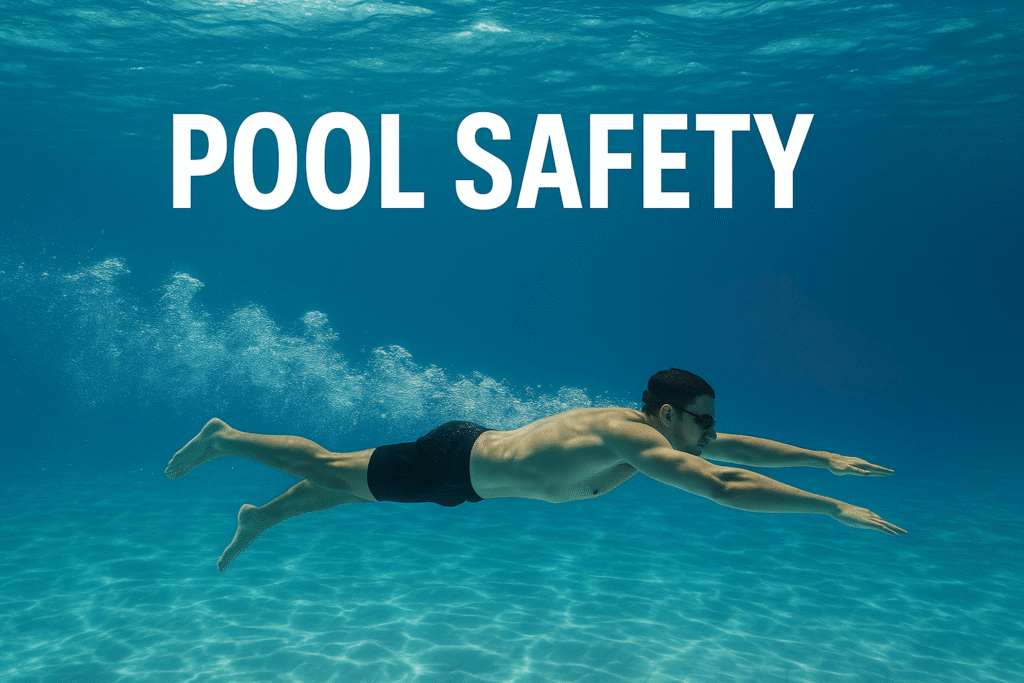Pool Safety should be a top priority whether you’re enjoying a backyard dip, managing a community pool, or maintaining aquatic centers at work. Water may be fun, but it also poses hidden dangers—especially for children, non-swimmers, and untrained staff.
This essential guide offers expert-backed pool safety tips to prevent accidents, injuries, and fatalities around water environments.
Why Pool Safety Matters
According to the World Health Organization (WHO), drowning is one of the top 10 causes of death for people aged 1–24 worldwide. In Canada, the Lifesaving Society reports that over 400 drownings occur annually, most of which are preventable.
Pool injuries also include slip and falls, chemical exposure, and electrical hazards, often affecting workers and guests alike.
Top Pool Safety Tips for Families and Facility Owners
Install and Maintain Pool Fencing
A four-sided fence with a self-closing, self-latching gate can reduce child drowning risk by up to 83%. Make sure the fence is at least 1.2 meters high and cannot be climbed.
- Use vertical bars rather than horizontal rails.
- Ensure there are no gaps wider than 10 cm.
- Lock the gate when the pool is not supervised.
Supervise Constantly – Never Assume
Adult supervision is non-negotiable. Assign a “Water Watcher” whose sole job is to watch swimmers. Drowning is silent and can occur in less than 30 seconds.
- Never rely solely on lifeguards or floaties.
- Stay within arm’s reach of young children.
- Avoid distractions like phones.
Keep Safety Equipment Nearby
Always have accessible tools such as:
- A reaching pole or shepherd’s crook
- A ring buoy or life preserver
- A fully stocked first-aid kit
- A poolside phone to call emergency services
Enforce Pool Rules Clearly
Create and display clear signage outlining your pool rules. For example:
- No diving in shallow areas
- No running near the pool
- No glass containers
- Shower before entering
Post rules in visible locations and educate guests on proper behavior.
Chemical and Maintenance Safety
Safe Chemical Storage and Handling
Improper handling of pool chemicals can lead to respiratory distress, chemical burns, or even explosions.
- Store chemicals in a cool, dry, and ventilated place.
- Always use PPE (Personal Protective Equipment) when handling.
- Never mix chemicals, especially chlorine and acids.
- Use appropriate labeling and safety data sheets (SDS).
Maintain Water Quality Regularly
Test chlorine and pH levels daily. Ensure filtration systems are running effectively to reduce pathogens like E. coli and Cryptosporidium.
- Ideal chlorine: 1–3 ppm
- Ideal pH: 7.2–7.8
- Log all maintenance tasks in a pool safety checklist
Electrical and Mechanical Safety
Pools require pumps, lights, and sometimes heaters. Improper wiring or lack of grounding can lead to electric shock drowning.
- Have all electrical systems inspected by a certified electrician.
- Install ground-fault circuit interrupters (GFCIs).
- Keep extension cords and power tools far from the pool area.
Training and Emergency Response
Train All Pool Users and Workers
Staff and frequent users should be trained in:
- CPR and AED usage
- Lifeguarding basics
- First aid
- Emergency evacuation procedures
Training boosts confidence and enables rapid response in crises.
Practice Emergency Drills
Whether you’re a facility manager or a parent, simulate emergencies:
- Child submerged drill
- Chemical spill response
- Power outage during swim session
- Evacuation for thunderstorm
Special Pool Safety Considerations
Pool Safety for Kids with Autism
Children with autism may be drawn to water but may lack the danger awareness. Consider:
- Swimming lessons tailored to sensory needs
- Visual boundary markers
- Non-verbal alert tools for distress
- Floating vests or full-coverage swimwear
More on Autism and Water Safety can be found at Autism Speaks.
Workplace Pools and OHSE Standards
Workplaces with aquatic facilities must comply with occupational safety standards. This includes:
- Regular workplace hazard assessments
- Certified lifeguards on duty
- Proper locker room ventilation and non-slip flooring
- Compliance with provincial OHSA or Canadian Centre for Occupational Health and Safety (CCOHS) guidelines
Further Reading
- Read more on Training and Safety Awareness in Workplaces
- Explore Heat Stress and Hydration Tips for Sports Facilities
- View our guide on PPE for Different Job Roles
Conclusion: Make Pool Safety a Daily Habit
Pool Safety begins before you even step into the water. From proper fencing and vigilant supervision to chemical handling and training, each element plays a critical role in saving lives.
Whether you’re hosting a family swim party or managing a commercial aquatic center, the cost of ignoring pool safety is far too high. Stay alert, stay prepared, and make safety the deepest part of your pool.

